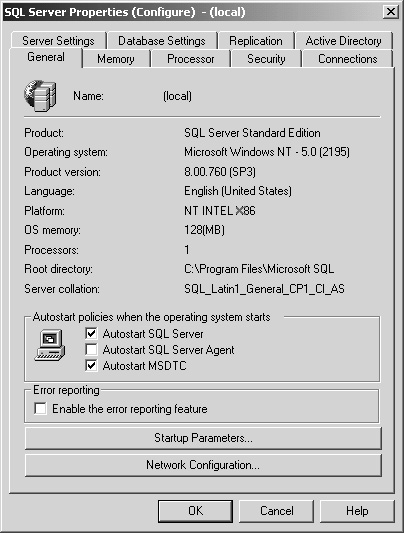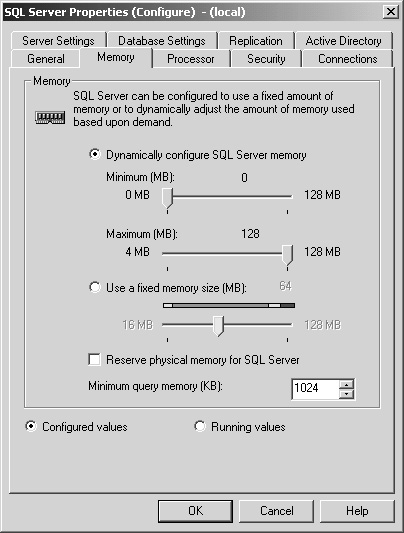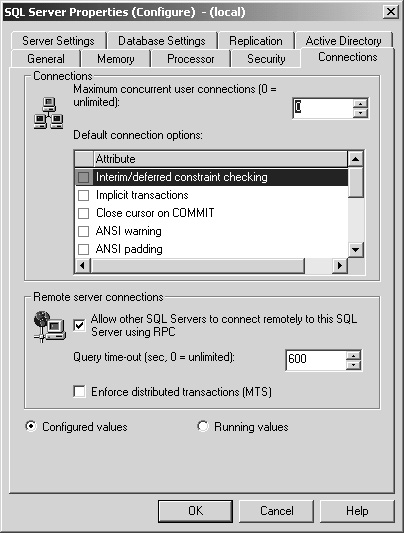Several SQL Server parameters
can affect how well the SMS database will be managed. SQL Server
self-manages most of these parameters—that is to say, you shouldn’t need
to fool around with them. In some scenarios, however, you might choose
to manually configure one or more parameters—for example, when trying to
optimize the use of server resources on the SQL Server system. In those
cases, when you install SQL Server you should pay particular attention
to the following SQL Server configuration parameters and set them
appropriately before installing SMS 2003: User Connections, Open
Objects, Memory, Locks, and Tempdb Size. Table 1 provides guidelines for setting these parameters for SQL Server 2000.
Table 1. SQL Server configuration parameters| Parameter | Guidelines |
|---|
| User Connections | SMS
2003 requires a minimum of 40 user connections for the site server and 2
connections for each SMS Administrator Console you plan to install. It
also requires five additional user connections for each instance of the
SMS Administrator Console, if more than five consoles will be running
concurrently on your site. You can set SMS 2003 to calculate this number
and configure it automatically during setup. Each installation of SMS
2003 requires 20 user connections. In SQL Server this allocation is made
dynamically at the time of the connection, providing more efficient
memory management. | | Open Objects | This
parameter indicates the number of tables, views, stored procedures, and
the like that can be open at a time. If you exceed the specified number
of open objects, SQL Server must close some objects before it can open
others, resulting in a performance hit. For most sites, a value of 1000
should be sufficient. For large sites, however, this number could be
5000 or more. Use SQL Server performance counters to track the number of
open objects in use to determine the optimum number for the SMS site.
Note that SQL Server sizes this number automatically. | | Memory | This
parameter indicates the amount of RAM that should be used for database
caching and management. SMS automatically allocates 16 MB of RAM for SQL
Server use. SQL Server allocates memory dynamically in 8 KB units. You
can define a range for SQL Server to use. | | Locks | This
parameter prevents users from accessing and updating the same data at
the same time. Because of the volume of information contained in the
database, Microsoft recommends setting this value from 5000 to 10,000
depending on the size of the database and the number of SMS
Administrator Consoles. | | Tempdb Size | This
temporary database and log are used to manage queries and sorts. By
default, the tempdb database and log information are maintained on the
same server running SQL. It’s recommended that the tempdb data device
size should be at least 20 percent of the SMS database size. SQL Server,
as you have by now surmised, sizes the tempdb database dynamically. |
Modifying Parameters for SQL Server 2000
To modify these parameter settings for SQL Server 2000, follow these steps:
1. | In
Enterprise Manager, select your SQL Server entry (the icon of a
computer with a white triangle within a green circle), right-click it,
and choose Properties from the context menu to display the SQL Server
Properties dialog box, shown in Figure 1.

| 2. | The SQL Server Properties dialog box contains tabs for those parameters for which you can modify settings. (Recall from Table 19-2 that SQL Server dynamically manages most SMS-specific parameters.)
| 3. | Select the Memory tab, shown in Figure 2.
Notice that the Dynamically Configure SQL Server Memory option is
enabled by default, although you can modify the memory range within
which SQL Server should manage memory allocation. You can also specify a
fixed amount of memory as well as identify the amount of memory to
allocate per user for query execution.

| 4. | Select the Connections tab, shown in Figure 3.
This tab displays the maximum number of user connections that were
configured for SQL Server during the SMS setup. By default, this value
is set to 0, which means that SQL Server will dynamically allocate
connections and appropriate resources to support them as required. The
allocation of user connections is a value you should monitor, especially
if you choose to enter your own maximum value. If you add SMS
Administrator Consoles or define additional site systems, you might need
to increase the maximum number of connections to accommodate the
increased resource demand by modifying this setting.

| 5. | When
you have finished making your changes, click OK to save them. You might
need to stop and then restart SQL Server to implement your changes. If
this step is necessary, a message box will display to that effect.
|
It’s also important that
the SMS clients synchronize their time with the SMS site server and the
server running SQL. SMS client computers will check their own system
clocks when determining when to execute a program or run an agent. You
can see how easily things can go awry if the server running SQL, the
site server, and the client computer system clocks are all set to
different times. A package might not execute at the time you expected,
or an inventory collection might not take place because the scheduled
times and the system clock are out of sync.
One
way to overcome this situation is to identify one server as your time
server for the SMS site. Have all your site systems, the SMS client
computers, and the server running SQL synchronize their times with the
time server. Or you might even consider making the server running SQL
the time server for the SMS site. Fortunately, Windows 2000 and higher
domains have this functionality built in.
|